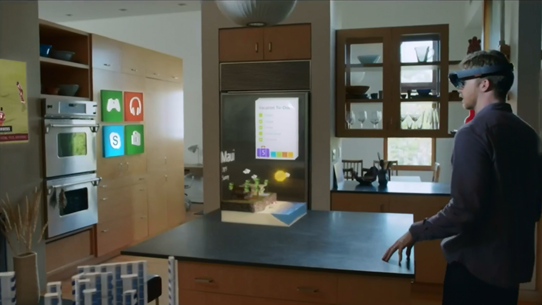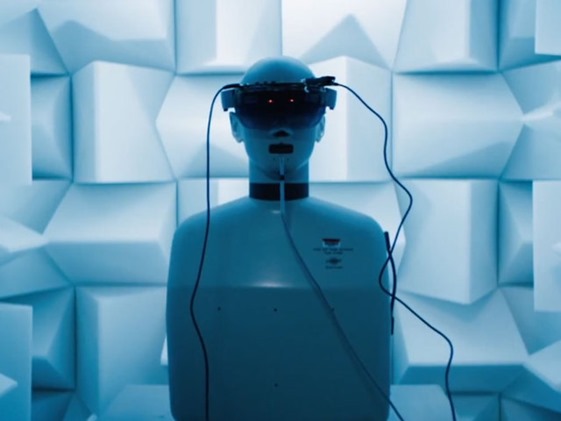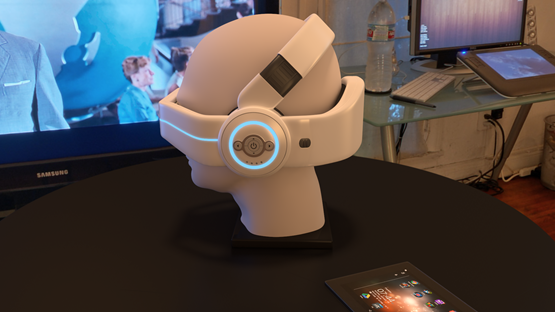The Genesis of Your Mixed Reality Future
With the recent announcement by Microsoft concerning the HoloLens project, the tech world is buzzing at the possibilities. There has been (of course) other initiatives in this field in the past few years going back to at least 2012 with Natalia from Sensics and more recently MetaOne and Atheer.
But what does this all mean for the general population?
Well, it means that while we were all looking at Virtual Reality as the “future” of the working environment, us futurists were quietly thinking about something far better and working toward it. If you are a reader of this blog, then you already know I’ve been in this field for a few years now and have been saying this was coming. It’s not a situation where I was right and everyone else was wrong, but I chose the side of innovation and futurism to know this was the next logical step forward.
It would seem other major corporations were on the same train of thought, which would explain why Google jokingly announced “Cardboard” in response to all the VR hype but then quietly dropped a substantial amount of money into MagicLeap for their AR development. In that MagicLeap raised over $500 million dollars in funding is a telling sign. (Yes, that’s a half a billion in funding)
One of the reasons I started falling back away from Virtual Reality is that I believe I’ve seen most of the possible use cases and that (as far as I can ascertain) everything else is merely a derivative of those main use cases. On a more logical assertion, the problem was that most of those use cases were just better served by Mixed Reality and not Virtual Reality.
There had to be something better... After all, is the evolution of synthetic environments actually just a few iterations of virtual reality head gear?
After seeing the initial wave of hype come and go for Oculus, I also saw a lot of the same sorts of “solutions” in third parties arising again. Sixense controllers, and an Omni treadmill, strapping a LeapMotion on the front of the headset as a peripheral addition.
But ultimately what all those things are trying to do is emulate what it would be like in a fully mixed reality environment. A headset that is built entirely on the premise of mixed reality wouldn’t have any of those issues or need for third party products for functionality.
If we were to look at the nascent AR industry over the past five years, we’d see that the paradigm of interaction has been the problem, not the use cases. No better could I demonstrate this than by all of the AR applications on tablets and smart phones – which again were touted as the future when they all started flooding the scene.
For instance, SemblanceAR (PlayAR) by Mark Skwarek in NYC is a major innovation, but by god is it crippled by being forced to work on a smart phone and tablet. The problem isn’t the AR application anymore but the paradigm of interaction and hardware it is being forced to run on. Google started an initiative in Project Tango to enable smart phones and tablets with RGBD cameras (3D Cameras) to try and alleviate that, but I think they got the point quickly when they decided to invest in MagicLeap.
So we’re back to the main point of HoloLens and what it really means to the industry. Let’s take a little bit and try to break this down.
Canary in the Mine
On the whole, HoloLens is an impressive demonstration. That being said, what Microsoft showed off to a select press was a lot of smoke and mirrors. After all, you didn’t likely hear about the lightweight glasses being hard tethered to multiple PCs to do the heavy computing, and you likely didn’t hear the perspective that the rooms and scenarios were very tightly controlled circumstances.
Instead, we heard about what it could do in those very tightly controlled circumstances and we were offered the Microsoft concept video as the “proof”. The concept video showing what they think it will look like and do whenever it is released (use cases) but by no means is it showing the headset in real time.
If they did show you the headset as it actually exists, it would look like this:
Sure, it can do amazing things under those controlled conditions, but that’s not a real world scenario. If I moved that coffee table, would it still be able to perform like the demo? Could it adjust the dynamic and still make it disappear and shatter into a million pieces?
At this point, that is unlikely.
Everything in those demonstrations was highly controlled and everything in those rooms were placed with a very specific purpose. It was intentional.
If so much as that coffee table were to be moved, the whole demonstration would have broken there on the spot, which would explain why the head guy in charge was so nervous showing it off.
That isn’t to say that the HoloLens is not damned impressive, because it is absolutely impressive for a number of reasons – assuming we disregard the negative things.
What it represents is less of a technical achievement and more of a canary in the mines situation in the synthetic environment industry.
Nobody outside of the early adopters and synthetic environment enthusiasts were interested in the MetaOne headset, the Atheer came and went without widespread public adoption, and even the ODG Headset coming out at the end of the year costs $5,000. Less obvious is that Microsoft actually paid ODG something like $200 million dollars for the patents (or they licensed it all) in order to suddenly announce HoloLens a year later.
So if you’re wondering what a pair of HoloLens glasses actually are, then you can safely assume it’s about on par with a pair of ODG Smart Glasses with a few minor improvements. Hopefully, Microsoft isn’t going to sell their version for $5,000. While all of this is really interesting to know (and gives us insight), the main point is that the world didn’t get excited when ODG announced their glasses (but some tech journalists did) and when Microsoft announced their own version based on the same technology, the whole world got excited overnight.
Allow me to reiterate: The mainstream public weren’t excited about this until a major player such as Microsoft came along and debuted their version of the same thing.
I mean, let’s be honest for a moment. When I said this was the future a couple of years ago, I distinctly remember being called out with the “put up or shut up” line now famously ingrained in my mind by a reader’s comment. Because clearly, as he would have had it, it was virtual reality and things like OpenSim that were the future.
That’s really the trouble with being a trend forecaster. You see it coming and nobody takes your word for it until it’s blatantly obvious and hindsight.
So yes, for the past few years I’ve been saying that VR isn’t going to be the miracle renaissance platform that everyone thought it would be, and I‘ve been also saying the field to pay attention to is Augmented and Mixed Reality. Don’t get me wrong, I absolutely love virtual reality and the Metaverse (capital M), but the virtual reality hype of it being the “’thneed” (Lorax reference there) is exaggerated by a light year.
That doesn’t mean virtual reality isn’t important, nor does it mean that the advances in that industry aren’t valuable. They are both immeasurably important in the bigger picture. I cannot possibly convey that notion enough.
What this actually means is that you can bet every major tech company is now pivoting and creating a future AR/MR Strategy for their companies. It’s no longer “What is our VR strategy?” but now “What is our AR/MR Strategy?”
That’s a huge paradigm shift.
But then again, we should have seen it coming. After all, nobody really gave VR much of a thought until some major corporations got involved. Whether it’s the initial hype of Second Life and all the brands coming in (and then leaving) or later on when an upstart Kickstarter project got bought out by Facebook for a few billion dollars.
When those things happen, it’s blood in the corporate water and the sharks come swimming up for the buffet.
Past Tense Future
In the short term, what you should expect to see is the synthetic environment industry suddenly focusing on Augmented and Mixed Reality devices in a rush to be “first to market”. At the very least, you’re going to see a lot of “me too” announcements in the next year or so.
This isn’t necessarily “bad” so to speak, because it advances a larger initiative that is bigger than all of them. So I’m actually happy about this canary in the mines situation.
Of course, in a more personal sense, I’m happy about this situation on the whole because it continues to advance what I was originally working on all this time (as well as the entire industry).
If anything, this actually accelerated things by a factor of ten. Where before I had a very hard time convincing pretty much anyone that this was the future (let alone understand what I was even describing) and they should be paying attention to it, now after this announcement every major corporation on Earth (just about) is quite eager to get in on the industry (at least if they’re smart).
I should know... because I have a meeting soon to discuss just that with one of them. I’m still not at liberty to discuss who that is (still), or disclose a lot of specific details about what it is and does, but you’ll be the first to know when I am cleared to do so. For now, I will share just a concept shot and let your mind wander.
Personally, I’m playing the long game scenario and looking to build it the best possible way it can be done, with emphasis on applying everything I’ve learned from virtual worlds research across the board for a better ecosystem and paradigm of interaction.
Ultimately, that is going to mean that we don’t focus on trying make a pair of sunglasses (because it’s underpowered that way) and at the same time we don’t make a gigantic helmet, (Sensics SmartGoggles). I believe the medium between the two is simply a lightweight, wireless (and convertible) headset that effectively turns real life (outside as well) into Second Life.
Now, this is completely aside to what I’m personally up to these days. The main take-away from these developments is that whether or not what I’m up to succeeds, you’re still going to see a revolution in synthetic environments with augmented reality wearable devices in the near future. I really think you’ll start seeing some serious contenders in the next few years.
I can only hope that in my own endeavors I can strive to push that even further for your continued benefit. Either way, the next few years are going to be pretty amazing – so look forward to it.










